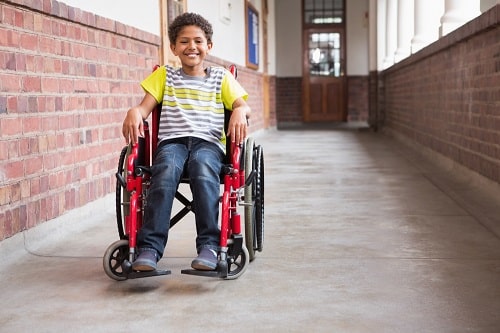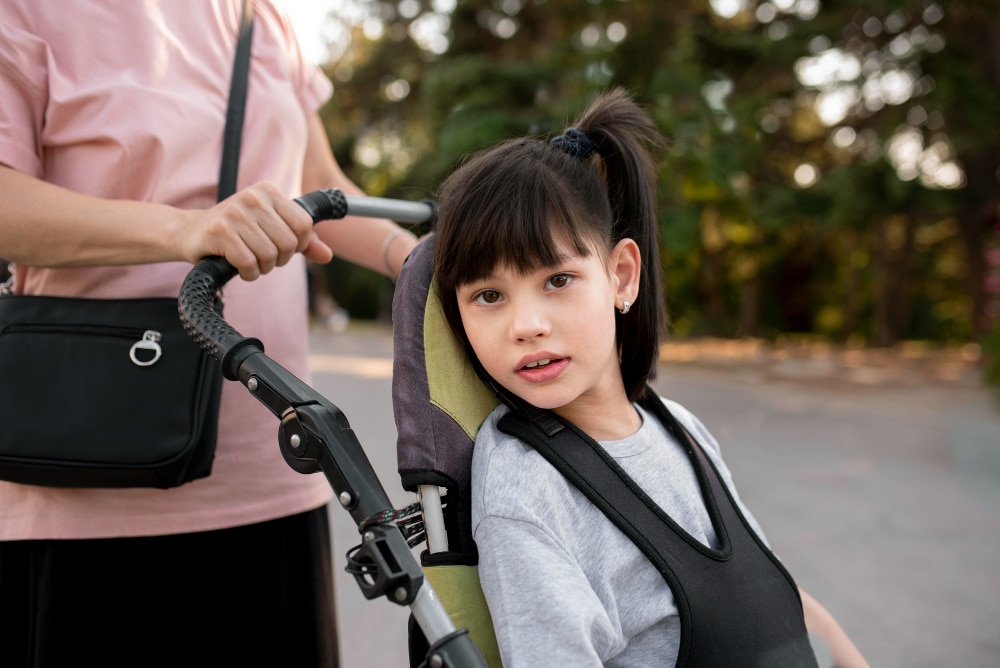If you’re the parent or guardian of a child who requires a paediatric wheelchair, you’ll know that picking a childrens wheelchair can be a nerve-racking – and often expensive – decision. Wheelchairs for kids require you to take into account their unique medical condition/s, physical abilities and lifestyle among other factors like cost and specifications.
In this article we hope to provide information on paediatric wheelchairs in a way that will help you make an informed choice. After all, a wheelchair is one of the most important mobility devices for someone living with disability. And this one needs to assist its user as they grow and develop!
In this article
- Children in wheelchairs – how many in Australia?
- 1. Childrens wheelchair sizes
- 2. Electric wheelchairs for kids vs manual wheelchairs
- 3. Power drive
- 4. Transport with a childrens wheelchair
- 5. Childrens wheelchairs and propelling
- 6. Tilt function on a childrens wheelchair
- A note on childrens wheelchair travel
- Insurance for childrens wheelchairs

Children in wheelchairs – how many in Australia?
In 2018 there were 357,500 Australian children (7.7% of children aged under 15) reported to be living with disability. At the time more than one third of them – 36.1% – had a need for assistance with mobility. We can use those figures as a guide to help us begin to understand today’s stats on wheelchairs for kids.
Although it’s not clear how many of these young Australians needed / need a childrens wheelchair, we can presume it’s a significant proportion. This means a lot of people find themselves needing to make the right decision around the wheels to their child’s movement.
When choosing a paediatric wheelchair, it’s important to think about a range of factors to ensure your child can safely enjoy an active and independent lifestyle. As you’re well aware, wheelchairs for kids should assist them in a better quality of life.
1. Childrens wheelchair sizes
Children usually grow pretty quickly. So, it’s important to find a kids wheelchair with frames and accessories that can support their physical growth. The less chopping and changing of a chair the better for the bank balance and/or your NDIS Capital budget, right?
(On that, read our wheelchair funding with the NDIS article if you haven’t already looked into it)
Young ones should always use the right sized kids wheelchair for their height, weight and place in space. Buy one that fits their current needs – never be tempted to buy a chair that’s too big because you think they’ll grow into it. This can have serious negative health and social repercussions.
Another important factor is that a child’s mobility and skills change over time. What your child can do one year might be noticeably different to the next. The children’s wheelchair must accommodate that, within reason.

2. Electric wheelchairs for kids vs manual wheelchairs
Generally, there are two types of wheelchairs: self-propelled and powered (or electric) wheelchairs. You’ll also find there are several power assist add-on devices that can be fitted to manual wheelchairs.
Your child’s medical conditions and/or disabilities, and how that affects their mobility, are the primary influences on the best type of childrens wheelchair for their unique circumstances. Electric versus manual should be a well-thought-out decision. You may even find both work together to provide the best solution for their ongoing needs.
Utilise the expertise of others
It’s always recommended to discuss wheelchair choice with a specialist, e.g. occupational therapist (OT) and/or physiotherapist. They should have enough experience to guide you and answer most of your questions. An OT’s assistance can also extend to using their sound understanding of wheelchair configuration to benefit your child – read our Occupational Therapy Wheelchair Scripting article.
While you’re writing up your questions for the therapists in your child’s life, do the same for wheelchair retailers you’ll speak with. They too, should have the experience to help guide you.
When it comes to the best childrens wheelchairs in Australia? We couldn’t make a judgement as it comes down to the individual. However, Zippie and Panthera are just a couple of brands making electric childrens wheelchairs worthy of checking out.

3. Power drive
When it comes to electric wheelchair drives, you’ll typically find front-wheel, mid-wheel, and rear-wheel drives. It’s all dependent on the location of the motor and the wheels’ placement on the chair.
Choosing the type of drive for your childrens wheelchair is dependent on their lifestyle. Check out our Choosing the Right Power Drive for Your Electric Wheelchair article to find out more.
4. Transport with a childrens wheelchair
It’s important to be able to transport your child in their wheelchair quickly and easily. Social occasions, medical appointments, visits to the shops, parks and more… All should be considered when you think about how your child will be transported best.
Many of today’s childrens wheelchairs have the option of tie-downs. They enable the child to be transported in a vehicle while sitting in their wheelchair. This often means kids can go along on school bus excursions, transported to and from school in a school van, and be driven easily in a specially modified family vehicle. These are called wheelchair accessible vehicles, or WAVs for short.
Wheelchairs with tie-downs need to pass ISO/Australian/NZ standards. A headrest is also required for this purpose. If this is something important to you, mention it to your clinician/therapist and/or wheelchair supplier. Then they’ll know to find a model with transport capability.
Read more on WAVs in our blog, which includes these articles:
- Features to Look for When Buying a Converted Car or WAV
- How to Choose Wheelchair Ramps for Cars
- Lifts and Hoists for Converted Vehicles

5. Childrens wheelchairs and propelling
Moving on… What’s the go with propelling versus attendant propel function wheelchairs? Good question.
The extent and type of your child’s mobility will dictate how well they can propel their paediatric wheelchair. In some cases, it may be necessary for you or another support team member to help push and guide the wheelchair.
Make sure the kids wheelchair you select offers both functions if that’s important for you and your child. Remember, the more they can move by themselves the more opportunity they’ll have for exploration and socialising. A crucial part of growing up!

6. Tilt function on a childrens wheelchair
If your child is in high need in that they need assistance with feeding and/or breathing, for example, you may want to look closely at a chair’s tilt function. A childrens wheelchair that can tilt several ways can be a terrific help with feeding, digestion, respiratory function and/or visual orientation.
Just as importantly, it can also help support the child’s positioning needs and comfort.
When they’re in a chair for many hours of the day it’s crucial that their paediatric wheelchair is comfortable and effective in its assistance of daily living and helping their development. Depending on their mobility, you may also want to consider a stand-up wheelchair. It allows your child to transition from a seated position to a standing position, offering numerous physical and psychological benefits.
Also be sure to check out these 8 tips to make a wheelchair more comfortable.
A note on childrens wheelchair travel
While some travel services and hotels provide accessible options for electric wheelchairs for kids (and adults), some may not be able to accommodate certain equipment. Sometimes, a manual chair that’s easier to fold up and store might be best.
Unfortunately, if your child can use only an electric wheelchair you may run into issues beyond simple accessibility.
For instance, on a flight, they may not be able to travel in their wheelchair, with the airline requiring they put it away. They could even need you to disassemble it. Your child may not be physically able to sit in a plane chair. Also, the paediatric wheelchair is at risk of being damaged when stored in the hold. So, take a picture pre-flight for proof of prior condition.
Further, you may need to pay extra for a ticket due to the extra weight of your heavy electric kids wheelchair. Read HuffPost’s great tips for air travel with an electric wheelchair.
Research, as always, is key
Think through all the modes of transport you will use, such as:
- Planes
- Cruise ships
- Ferries
- Buses
- Trains
- Hire cars
- Taxis
- Ridesharing
You also need to make sure each potential accommodation provider has accessibility for children’s wheelchairs from the front door, into and around your room, and throughout the property.
Remember: Always look into your travel providers’ policies and discuss accessibility with them to be on the safe side.

Read more about kids with wheelchairs and/or travelling with a chair:
- Buying Presents for Children with Disabilities
- Getting Kids into Adaptive Sports – What’s Out There?
- 5 Kids Show Characters Giving Disability Visibility
- These Toys with Disabilities are Helping Teach Inclusivity
- Our Favourite Wheelchair Travel Blogs
- Kids Roll Through Halloween in Wheelchair Style
Insurance for childrens wheelchairs
You know how important your child’s paediatric wheelchair is to their independence. Wheelchairs can get damaged and repairing or replacing them is expensive. That’s why it’s important to think seriously about wheelchair insurance and about insurance for wheelchair accessible vehicles.
Contact Blue Badge Insurance if you have any questions. We’re happy to help and after many years as a disability insurance specialist, we know what we’re talking about.








